Plastic Response and Failure of the Cruciform Structure under In-Plane Load
Abstract
1. Introduction
2. Experiments of the Cruciform Structure
2.1. Specimen
2.2. Quasi-Static Indentation Test Set-Up
2.3. Falling Weight Impact Test
2.4. Experimental Results and Comparison
2.4.1. Quasi-Static Test Results
2.4.2. Falling Weight Impact Test Results
2.4.3. Comparison of Quasi-Static Test and Dynamic Test
3. Failure Criteria
3.1. EPS Criterion
3.2. BWH Criterion
3.3. RTCL Criterion
4. Numerical Simulation Setup
4.1. True Stress–Strain Relationship
4.2. Element Size Sensitivity
4.3. Definition of Failure Criteria
4.4. Parameter Settings of Finite Element Model
5. FE Results and Discussion
5.1. Effect of Failure Criteria on FE Results
5.2. Effect of Mesh Size on FE Results
5.3. Comparison of the Dynamic and Static Response of the Structure
6. Analysis of the Effect of Friction Coefficient and Indenter Offset
6.1. Effect of Coefficient of Friction
6.2. Effect of Indenter Offset
7. Conclusions
- When the cruciform structure in a typical hull structure is subjected to in-plane loading, the structural deformation mainly has the following processes: axial compression deformation of the structure, with a rapid increase in structural resistance; flexural deformation of the structure, with a slight decrease in structural resistance; crease deformation of the cruciform structure, with a smooth increase in structural resistance; and tearing of the front panel, with a decrease in structural load carrying capacity.
- When subjected to the impact load of a rigid indenter, the structure’s deformation range is smaller than the quasi-static load, and the deformation is relatively concentrated at the collision location. In the 3 m drop impact condition, the initial peak impact load increases by nearly 20% compared to the quasi-static collision scenario, and the average impact force increases by approximately 13% before structural failure. This indicates that the structure has a higher energy absorption capacity in the 3 m drop impact condition compared to the quasi-static collision scenario.
- The EPS failure criterion in the simulation in this scenario would prematurely determine the failure of the junction due to the localized compressive deformation produced by the unit. The BWH failure criterion struggles to determine the failure of the structure, and the crashworthiness of the structure evaluated by this criterion is higher than that of the actual scenario. The RTCL failure criterion is more suitable for this complex stress state crash scenario, and the tearing phenomenon of the upper panel is better simulated.
- The height of the wrinkles produced by the cruciform structure is closely related to the mesh size. The height of the wrinkles produced by a large mesh model is relatively high, and the area where the subsequent membrane tensile deformation occurs in the belly beam that makes up the cruciform structure is relatively large. The structure’s resistance is also relatively small in the large mesh model. In contrast, a small mesh model produces smaller wrinkles, and subsequent wrinkle formation occurs earlier than in the large mesh model.
Author Contributions
Funding
Institutional Review Board Statement
Informed Consent Statement
Data Availability Statement
Conflicts of Interest
References
- Oil Tanker Spill Statistics 2022. Available online: https://www.itopf.org/knowledge-resources/data-statistics/statistics/ (accessed on 23 May 2023).
- Cho, S.-R.; Lee, H.-S. Experimental and analytical investigations on the response of stiffened plates subjected to lateral collisions. Mar. Struct. 2009, 22, 84–95. [Google Scholar] [CrossRef]
- Liu, K.; Wang, Z.; Tang, W.; Zhang, Y.; Wang, G. Experimental and numerical analysis of laterally impacted stiffened plates considering the effect of strain rate. Ocean Eng. 2015, 99, 44–54. [Google Scholar] [CrossRef]
- Liu, B.; Soares, C.G. Effect of strain rate on dynamic responses of laterally impacted steel plates. Int. J. Mech. Sci. 2019, 160, 307–317. [Google Scholar] [CrossRef]
- Yang, L.; Wang, D.-Y. Experimental and numerical investigation on the response of stiffened panels subjected to lateral impact considering material failure criteria. Ocean Eng. 2019, 184, 193–205. [Google Scholar] [CrossRef]
- Alsos, H.S.; Amdahl, J. On the resistance to penetration of stiffened plates, Part I–Experiments. Int. J. Impact Eng. 2009, 36, 799–807. [Google Scholar] [CrossRef]
- Alsos, H.S.; Amdahl, J.; Hopperstad, O.S. On the resistance to penetration of stiffened plates, Part II: Numerical analysis. Int. J. Impact Eng. 2009, 36, 875–887. [Google Scholar] [CrossRef]
- Zhang, M.; Liao, X.; Li, S.; Song, S.; Liu, J.; Hu, Z. Experimental and numerical investigation of the damage characteristics of a ship side plate laterally punched by a scaled raked bow indenter. Ocean Eng. 2023, 280, 114808. [Google Scholar] [CrossRef]
- Wang, G.; Arita, K.; Liu, D. Behavior of a double hull in a variety of stranding or collision scenarios. Mar. Struct. 2000, 13, 147–187. [Google Scholar] [CrossRef]
- Zhang, M.; Liu, J.; Hu, Z.; Zhao, Y. Experimental and numerical investigation of the responses of scaled tanker side double-hull structures laterally punched by conical and knife edge indenters. Mar. Struct. 2018, 61, 62–84. [Google Scholar] [CrossRef]
- Villavicencio, R.; Kim, Y.-H.; Cho, S.-R.; Soares, C.G. Deformation process of web girders in small-scale tanker double hull structures subjected to lateral impact. Mar. Struct. 2013, 32, 84–112. [Google Scholar] [CrossRef]
- Chen, B.-Q.; Liu, B.; Guedes Soares, C. Experimental and numerical investigation on a double hull structure subject to collision. Ocean Eng. 2022, 256, 111437. [Google Scholar] [CrossRef]
- Urban, J. Crushing and Fracture of Lightweight Structures. Ph.D. Thesis, Technical University of Denmark, Kongens Lyngby, Denmark, 2003. [Google Scholar]
- Zhou, C.; Li, T.; Ming, S.; Song, Z.; Wang, B. Effects of welding on energy absorption of kirigami cruciform under axial crushing. Thin Wall Struct. 2019, 142, 297–310. [Google Scholar] [CrossRef]
- Haris, S.; Amdahl, J. Crushing resistance of a cruciform and its application to ship collision and grounding. Ships Offshore Struct. 2012, 7, 185–195. [Google Scholar] [CrossRef]
- Haris, S.; Amdahl, J. An analytical model to assess a ship side during a collision. Ships Offshore Struct. 2012, 7, 431–448. [Google Scholar] [CrossRef]
- Hayduk, R.J.; Wierzbicki, T. Extensional collapse modes of structural members. Comput. Struct. 1984, 18, 447–458. [Google Scholar] [CrossRef]
- Yang, P.; Caldwell, J. Collision energy absorption of ships’ bow structures. Int. J. Impact Eng. 1988, 7, 181–196. [Google Scholar] [CrossRef]
- Tørnqvist, R. Design of Crashworthy Ship Strucures; Technical University of Denmark: Kongens Lyngby, Denmark, 2003. [Google Scholar]
- Zhang, L.; Egge, E.-D.; Bruhns, H. Approval Procedure Concept for Alternative Arrangements; Germanischer Lloyd: Hamburg, Germany, 2004. [Google Scholar]
- Peschmann, J. Energy absorption computations of ship steel structures under collision and grounding (translated from German language). Schriftenreih e Schiffbau/TU Hambg.-Harbg. 2001, 613, 4269–4355. [Google Scholar]
- Lehmann, E.; Peschmann, J. Energy absorption by the steel structure of ships in the event of collisions. Mar. Struct. 2002, 15, 429–441. [Google Scholar] [CrossRef]
- Alsos, H.S. Ship grounding: Analysis of Ductile Fracture, Bottom Damage and Hull Girder Response. Ph.D. Thesis, Norwegian University of Science and Technology, Trondheim, Norway, 2008. [Google Scholar]
- Yagi, S.; Kumamoto, H.; Muragishi, O.; Takaoka, Y.; Shimoda, T. A study on collision buffer characteristic of sharp entrance angle bow structure. Mar. Struct. 2009, 22, 12–23. [Google Scholar] [CrossRef]
- Kõrgesaar, M.; Romanoff, J. Influence of softening on fracture propagation in large-scale shell structures. Int. J. Solids Struct. 2013, 50, 3911–3921. [Google Scholar] [CrossRef][Green Version]
- Kõrgesaar, M.; Remes, H.; Romanoff, J. Size dependent response of large shell elements under in-plane tensile loading. Int. J. Solids Struct. 2014, 51, 3752–3761. [Google Scholar] [CrossRef]
- Marinatos, J.; Samuelides, M. Material characterization and implementation of the RTCL, BWH and SHEAR failure criteria to finite element codes for the simulation of impacts on ship structures. In Proceedings of the International Conference of Collision and Groundings of Ships (ICCGS-2013), Trondheim, Norway, 17–19 June 2013; pp. 57–67. [Google Scholar]
- Lu, Y.; Liu, K.; Wang, Z.; Tang, W. Modelling of ductile fracture in ship structures subjected to quasi-static impact loads. Int. J. Impact Eng. 2021, 156, 103941. [Google Scholar] [CrossRef]
- Lu, Y.; Liu, K.; Wang, Z.; Tang, W.; Amdahl, J. Development of ductile fracture modelling approach in ship impact simulations. Ocean Eng. 2022, 252, 111173. [Google Scholar] [CrossRef]
- Costas, M.; Morin, D.; Hopperstad, O.S.; Børvik, T.; Langseth, M. A through-thickness damage regularisation scheme for shell elements subjected to severe bending and membrane deformations. J. Mech. Phys. Solids 2019, 123, 190–206. [Google Scholar] [CrossRef]
- Calle, M.; Alves, M. A review-analysis on material failure modeling in ship collision. Ocean Eng. 2015, 106, 20–38. [Google Scholar] [CrossRef]
- Hill, R. On discontinuous plastic states, with special reference to localized necking in thin sheets. J. Mech. Phys. Solids 1952, 1, 19–30. [Google Scholar] [CrossRef]
- Bressan, J.; Williams, J. The use of a shear instability criterion to predict local necking in sheet metal deformation. Int. J. Mech. Sci. 1983, 25, 155–168. [Google Scholar] [CrossRef]
- Rice, J.R.; Tracey, D.M. On the ductile enlargement of voids in triaxial stress fields*. J. Mech. Phys. Solids 1969, 17, 201–217. [Google Scholar] [CrossRef]
- Cockcroft, M. Ductility and workability of metals. J. Metals 1968, 96, 2444. [Google Scholar]
- GB/T228. 1-2010; Metallic Materials-Tensile Testing-Part 1: Method of Test at Room Temperature. China Standard Press: Beijing, China, 2011.
- Villavicencio, R.; Soares, C.G. Numerical plastic response and failure of a pre-notched transversely impacted beam. Ships Offshore Struct. 2012, 7, 417–429. [Google Scholar] [CrossRef]
- Liu, B.; Villavicencio, R.; Guedes Soares, C. Plastic Response and Failure Prediction of Stiffened Plates Punched by a Wedge. In Proceedings of the ASME 2013 32nd International Conference on Ocean, Offshore and Arctic Engineering. Volume 2B: Structures, Safety and Reliability, Nantes, France, 9–14 June 2013; Volume 2. [Google Scholar]
- Nassiraei, H.; Lotfollahi-Yaghin, M.A.; Ahmadi, H. Structural behavior of tubular T/Y-joints with collar plate under static in-plane bending. J. Constr. Steel Res. 2016, 123, 121–134. [Google Scholar] [CrossRef]
- Nassiraei, H.; Lotfollahi-Yaghin, M.A.; Ahmadi, H.; Zhu, L. Static strength of doubler plate reinforced tubular T/Y-joints under in-plane bending load. J. Constr. Steel Res. 2017, 136, 49–64. [Google Scholar] [CrossRef]
- Liu, K.; Liu, B.; Villavicencio, R.; Wang, Z.; Guedes Soares, C. Assessment of material strain rate effects on square steel plates under lateral dynamic impact loads. Ships Offshore Struct. 2018, 13, 217–225. [Google Scholar] [CrossRef]
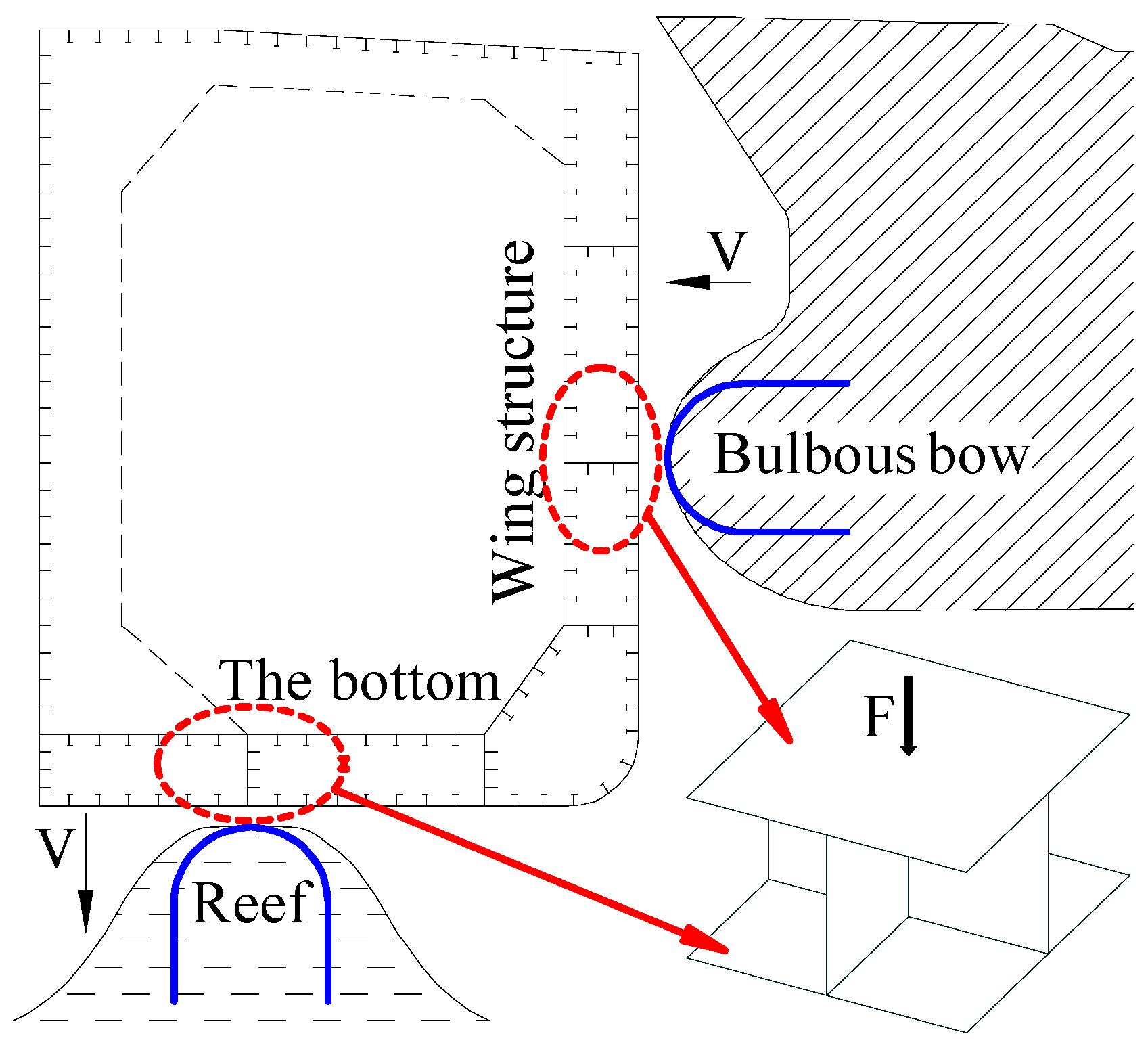
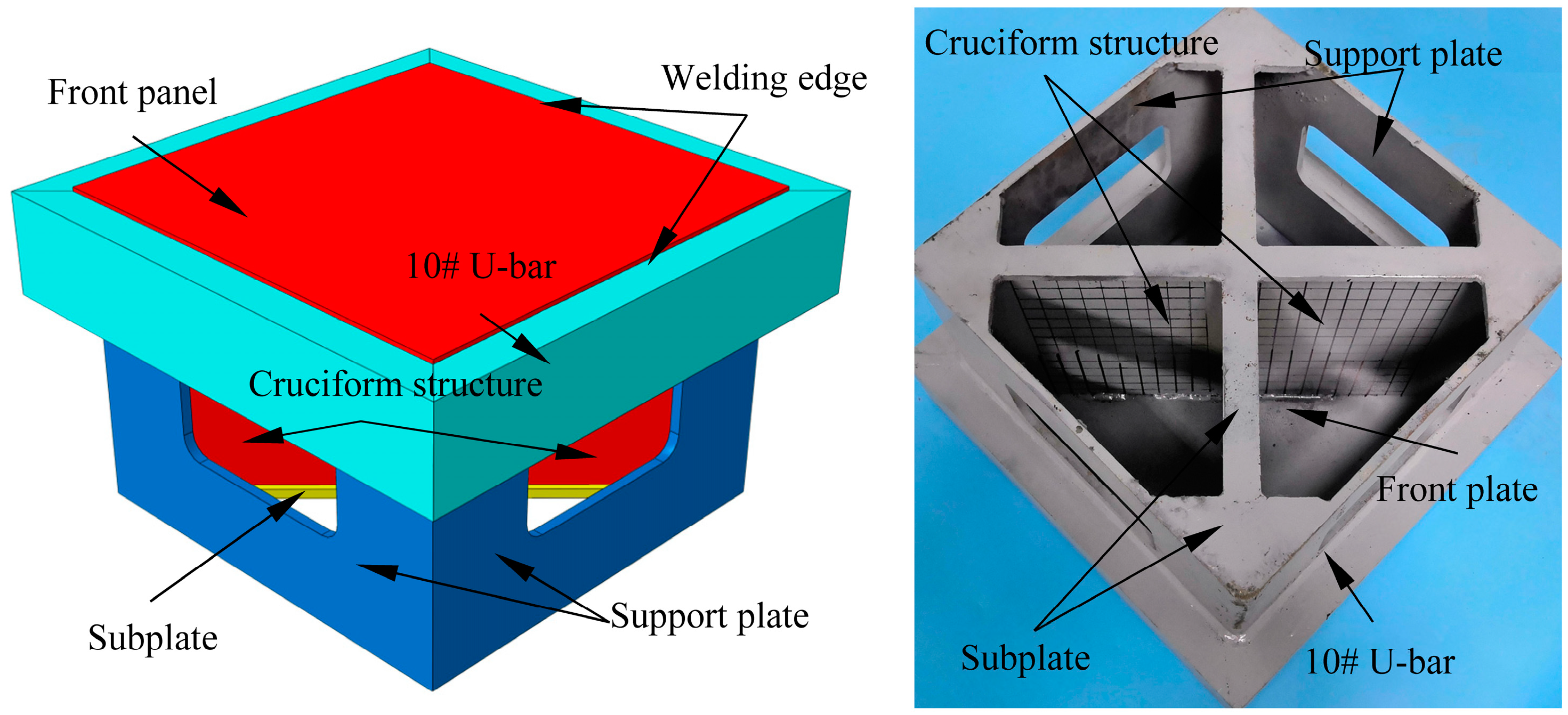
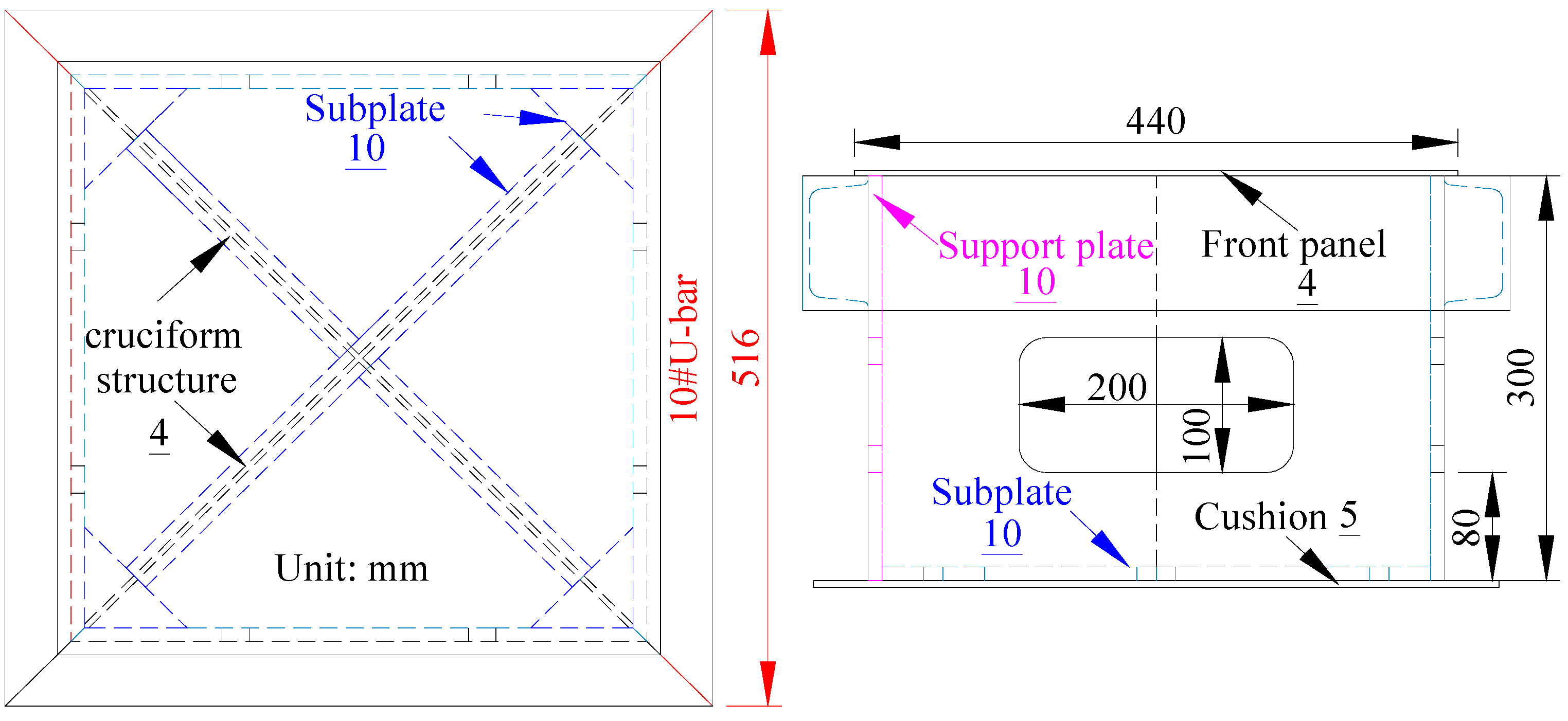
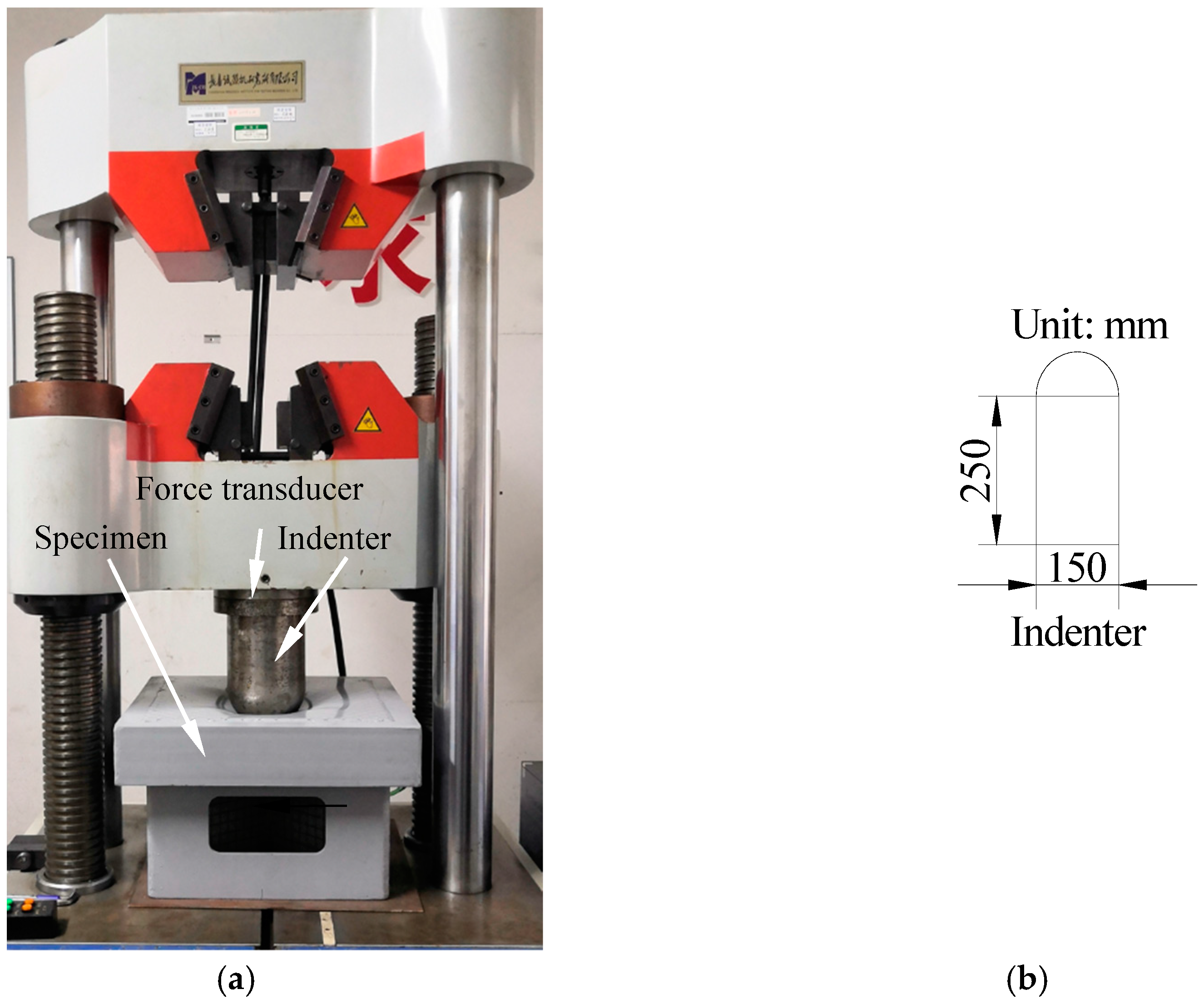
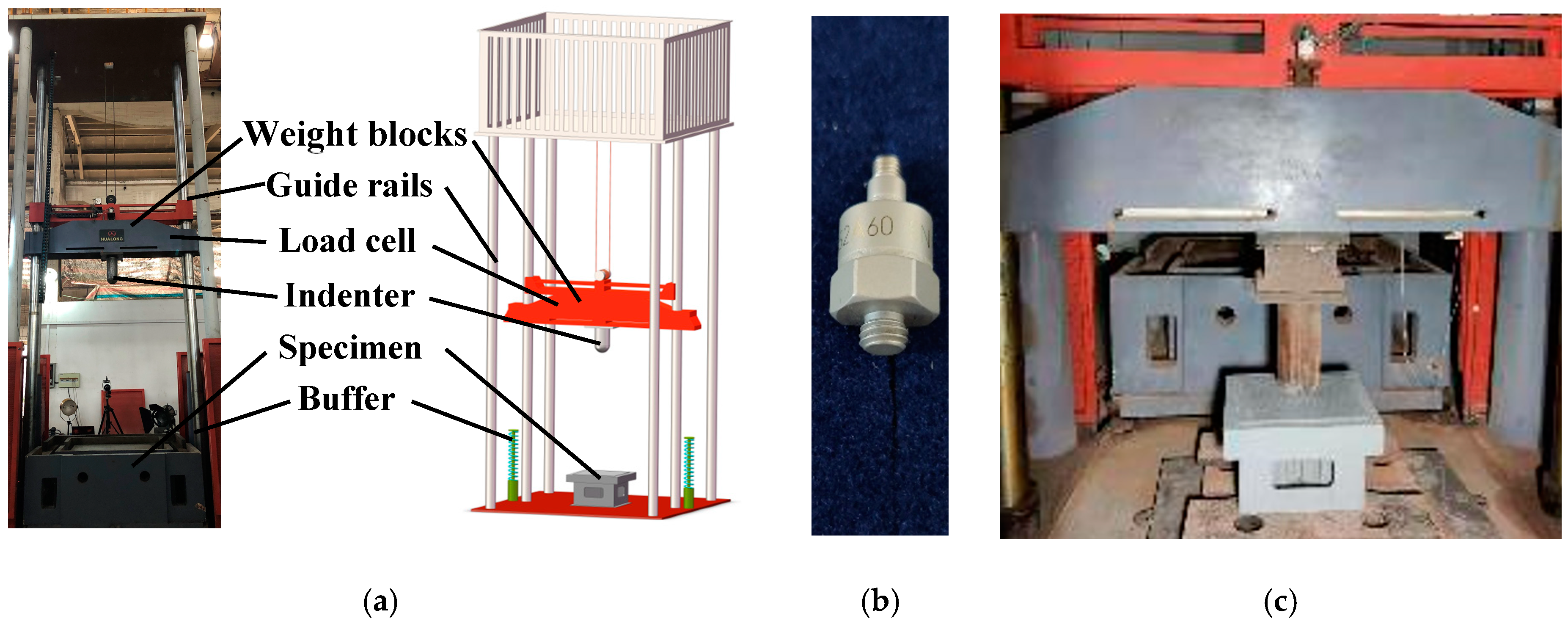
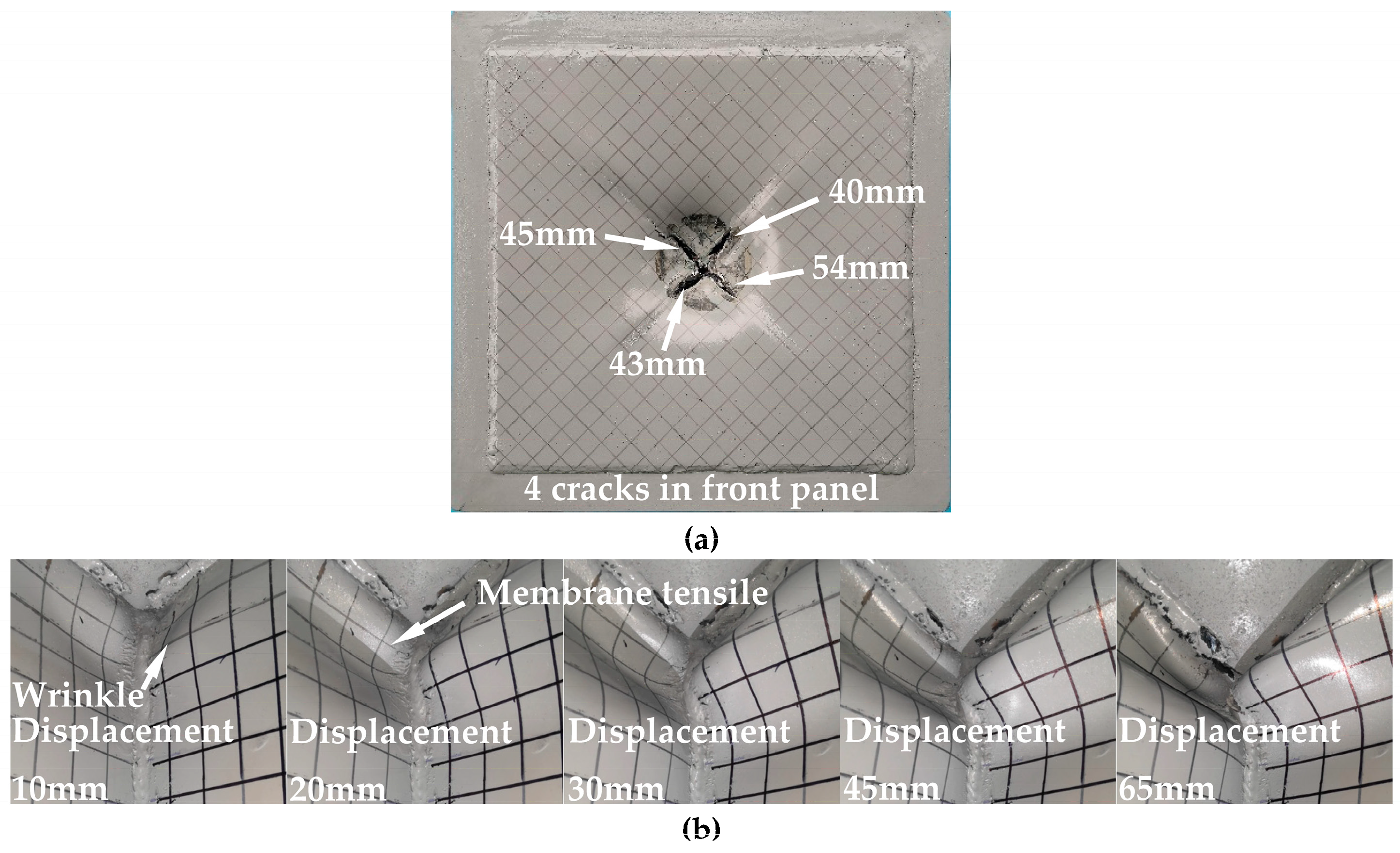
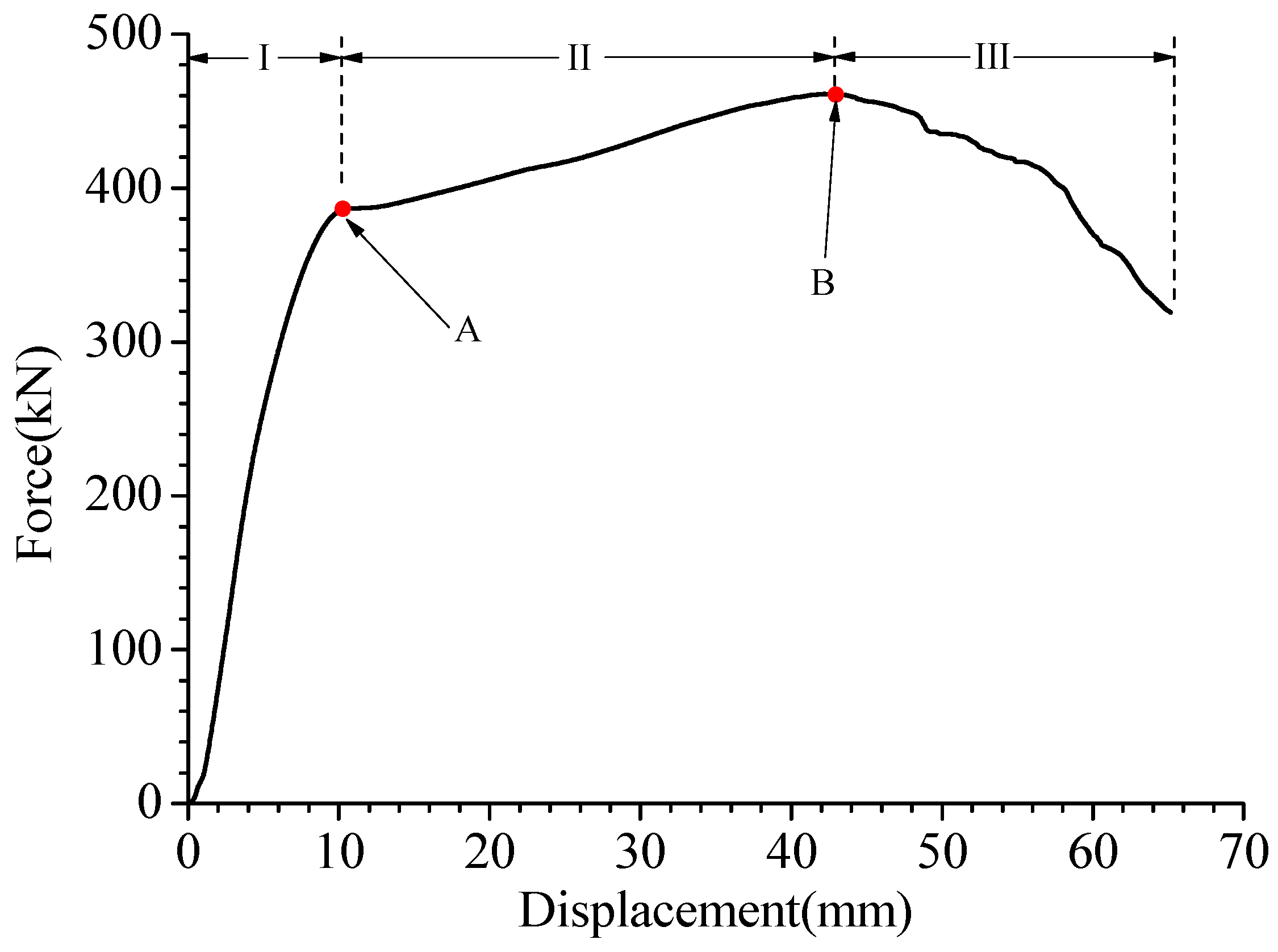
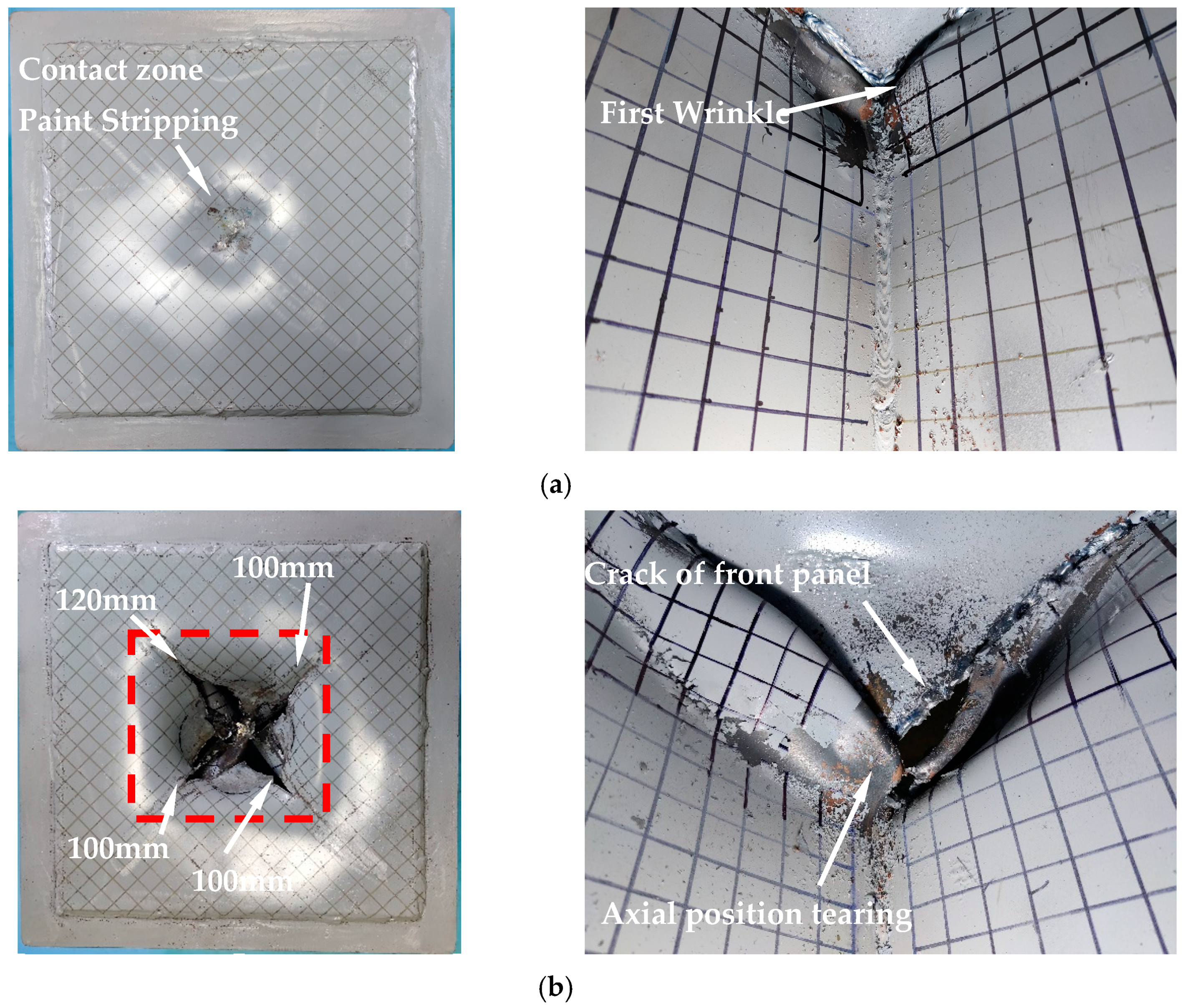

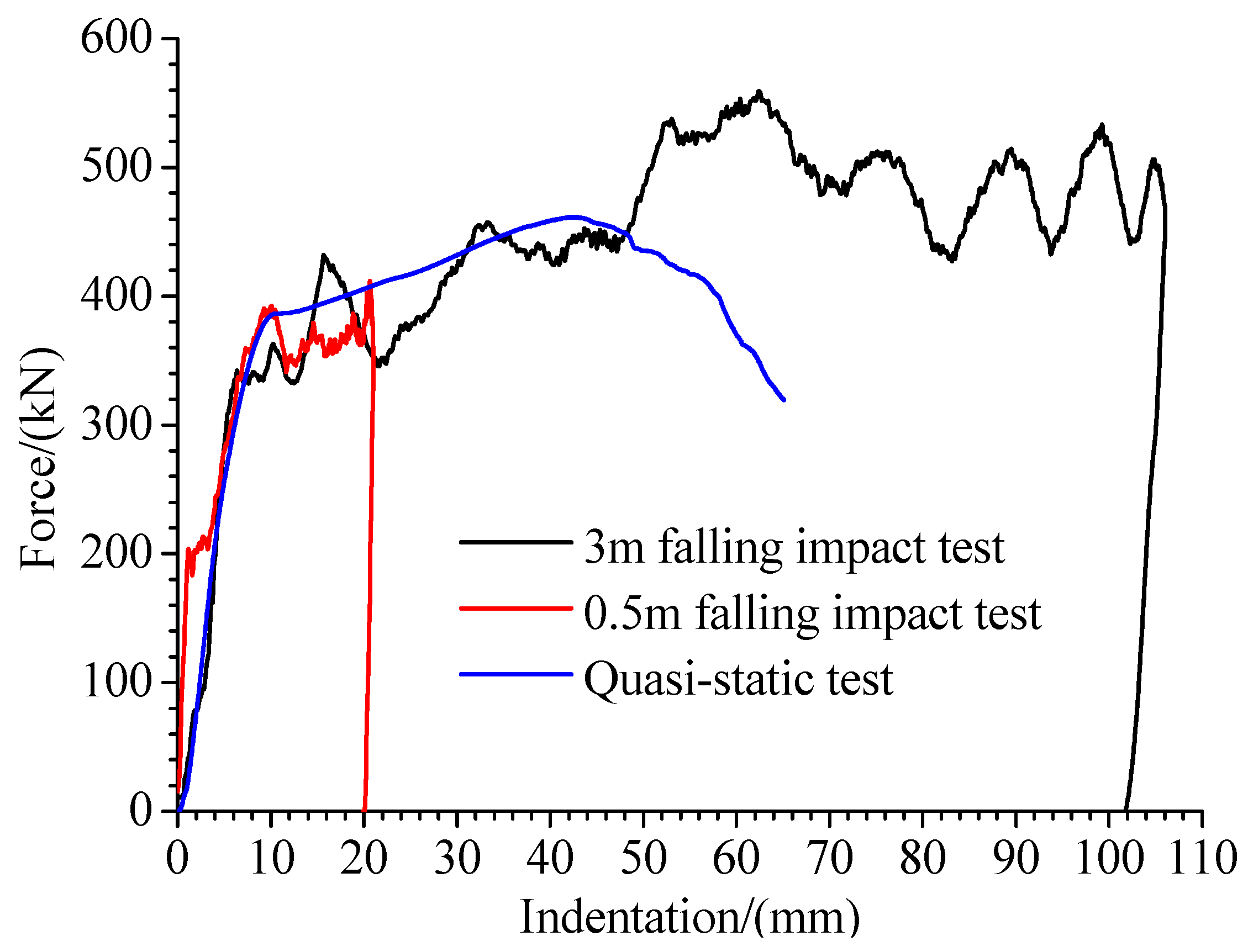
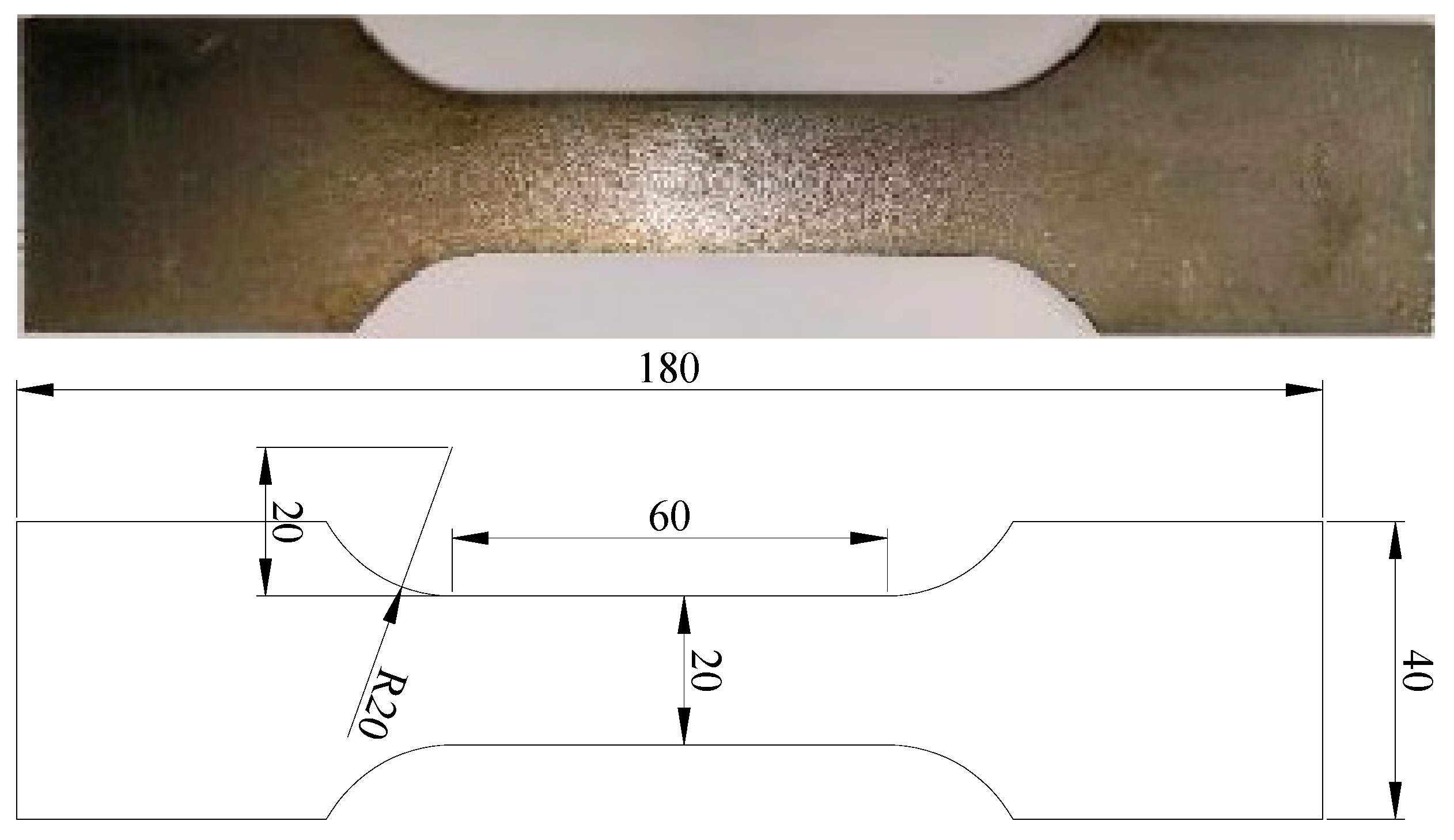
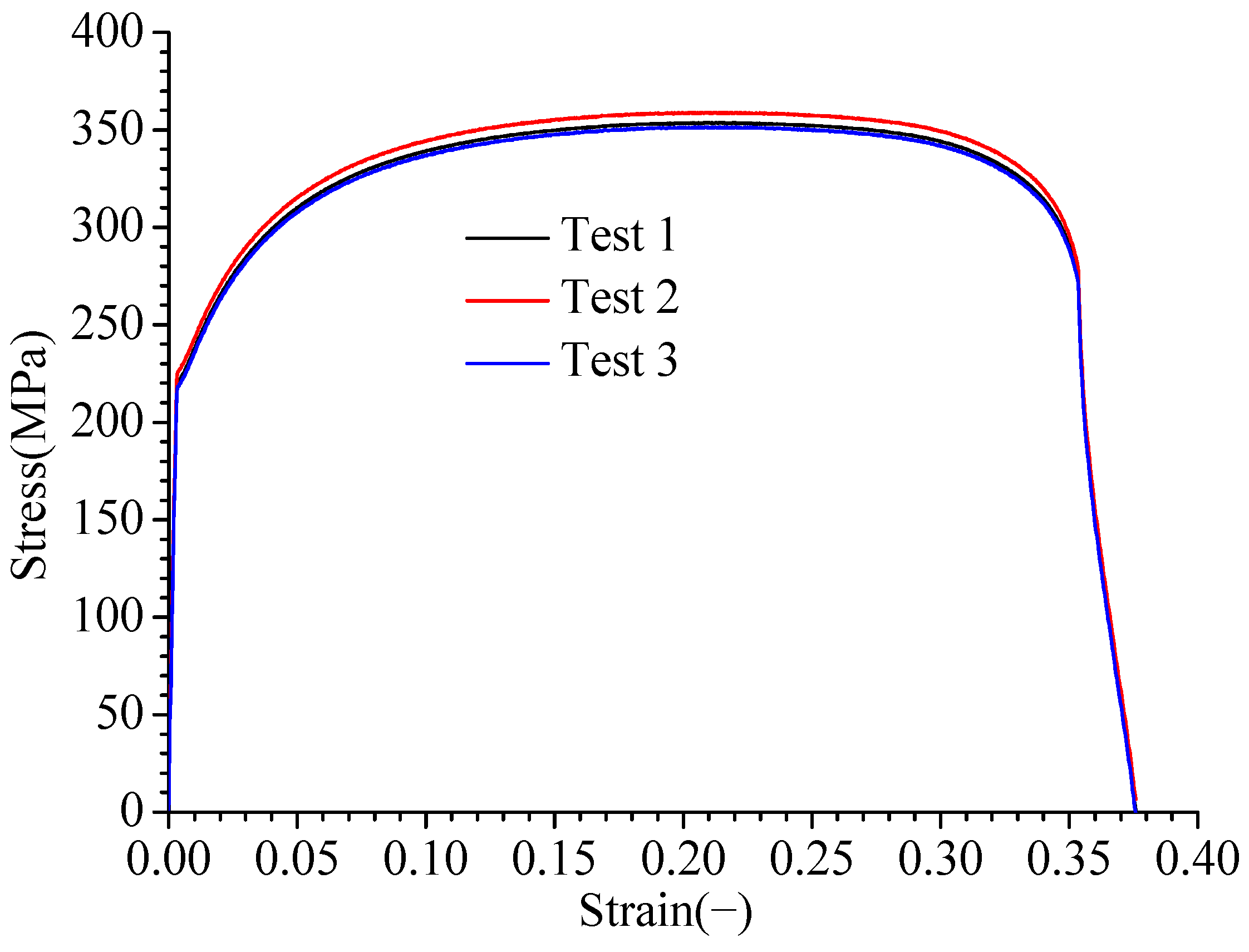
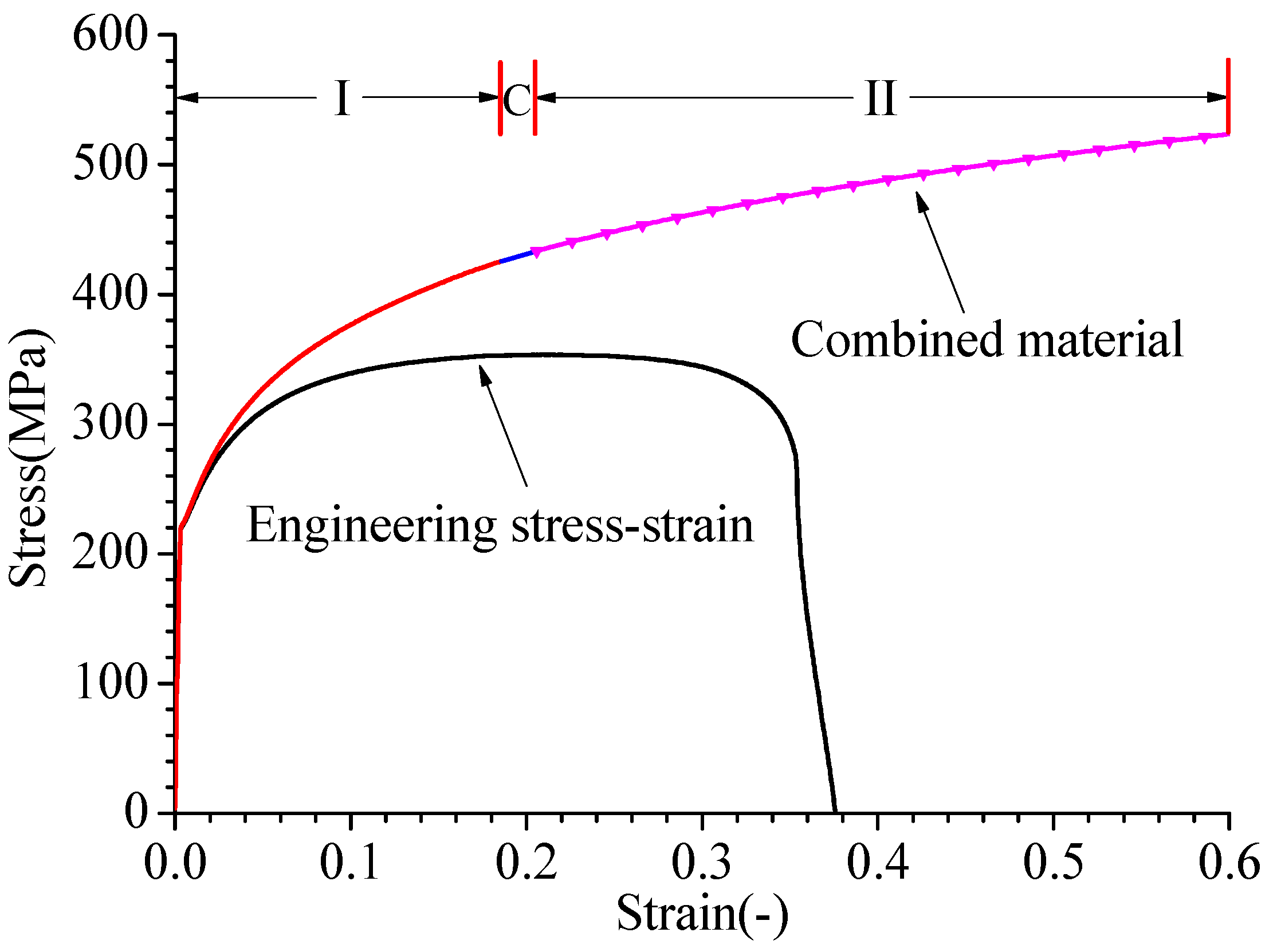
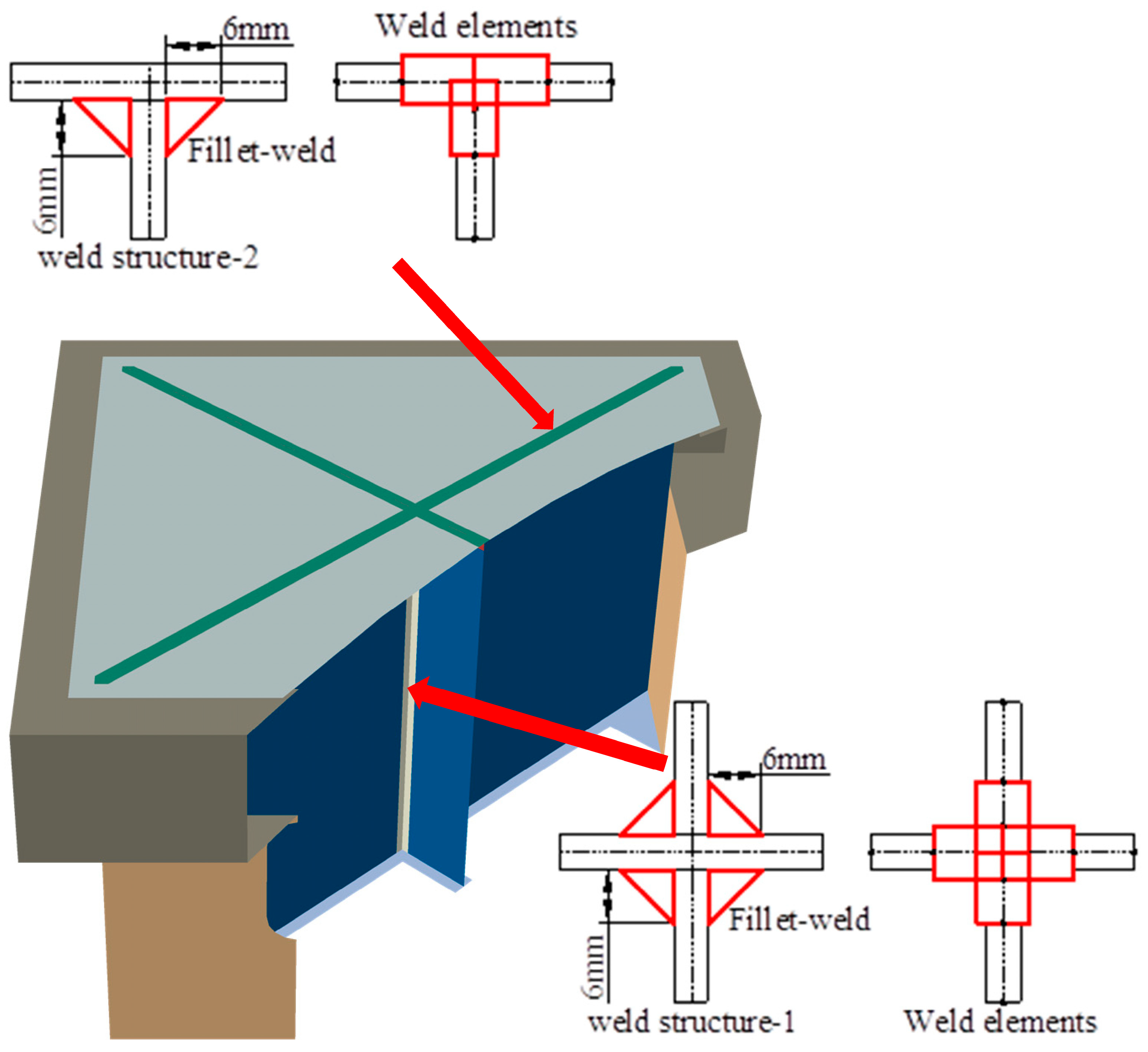
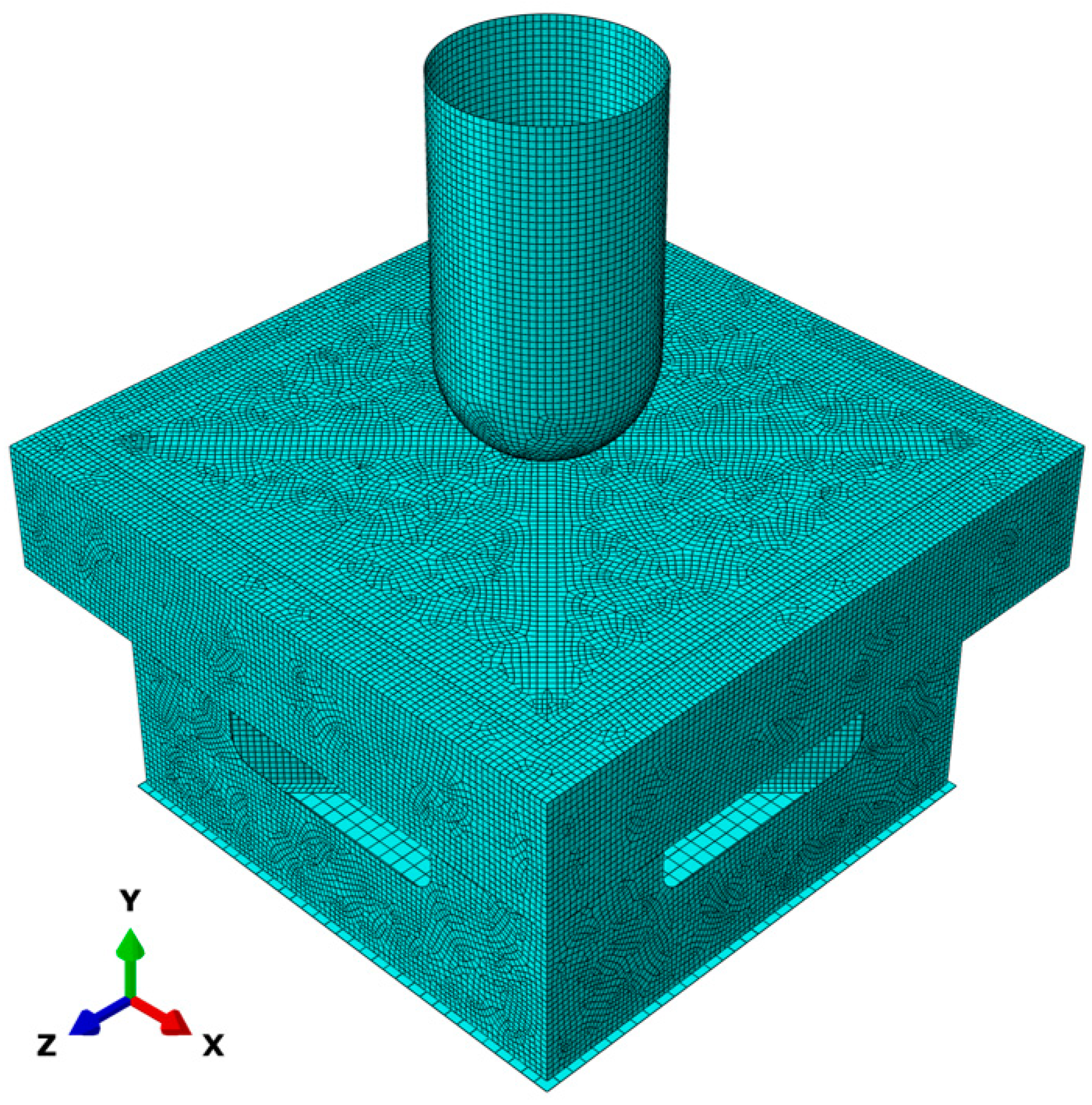

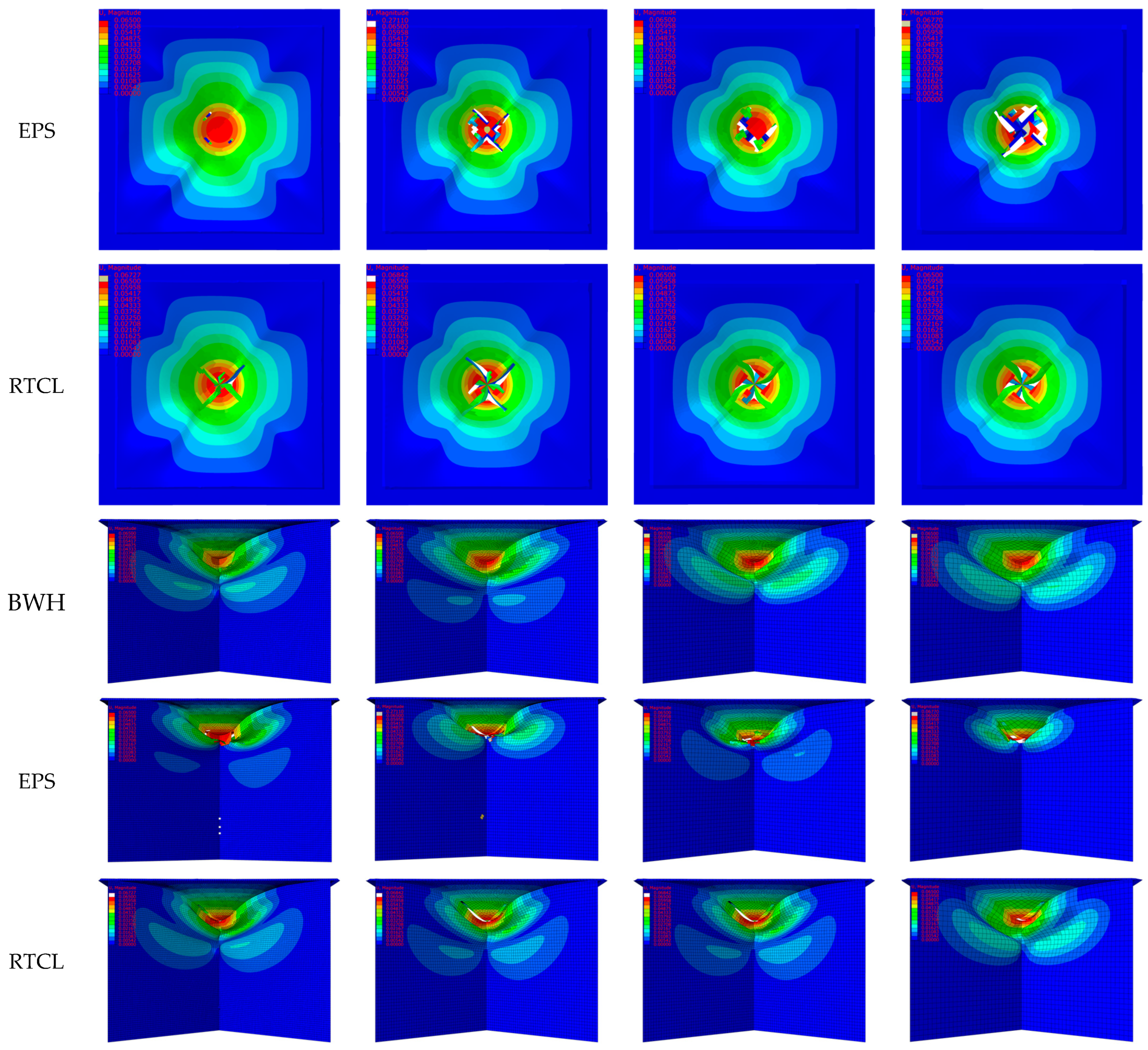
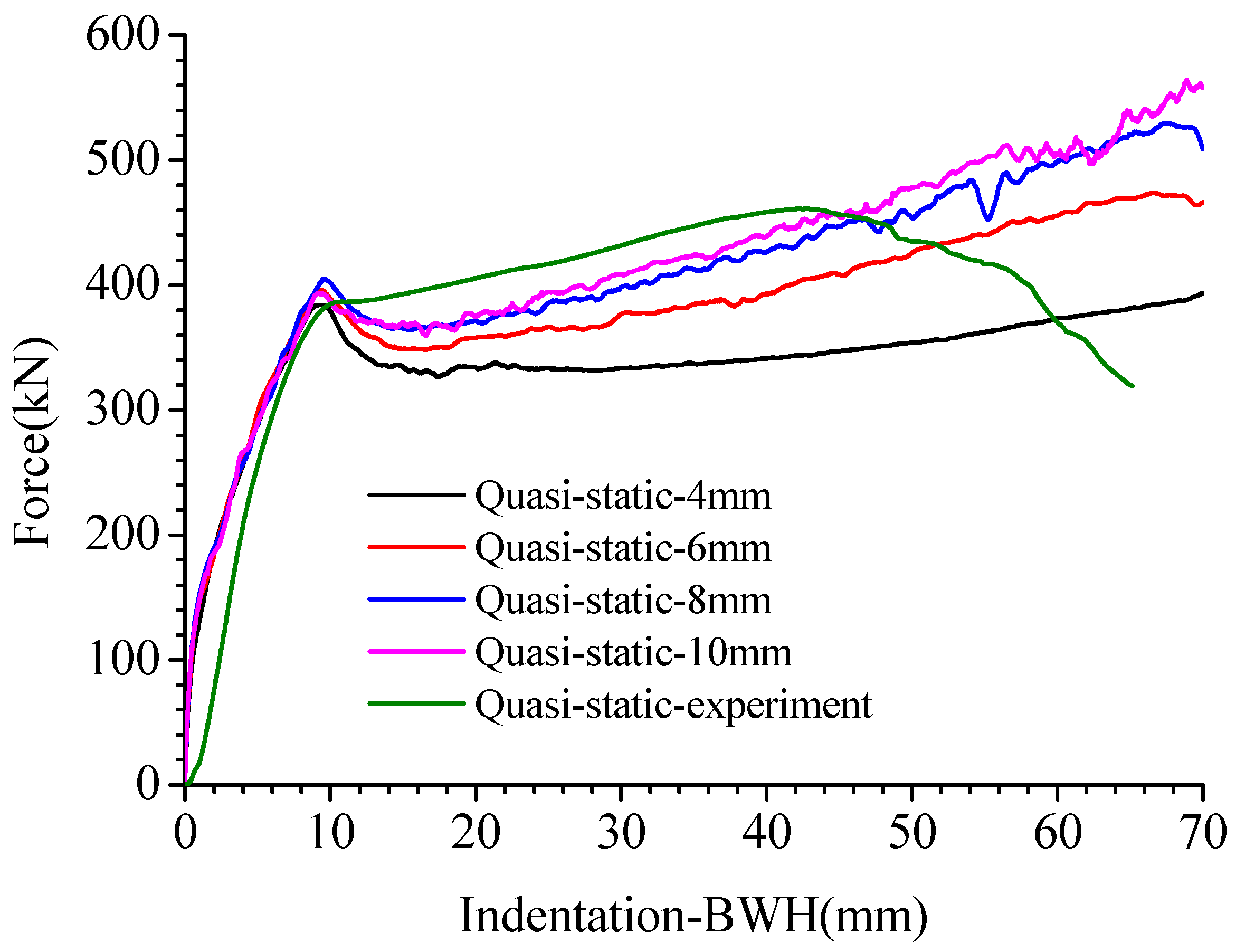

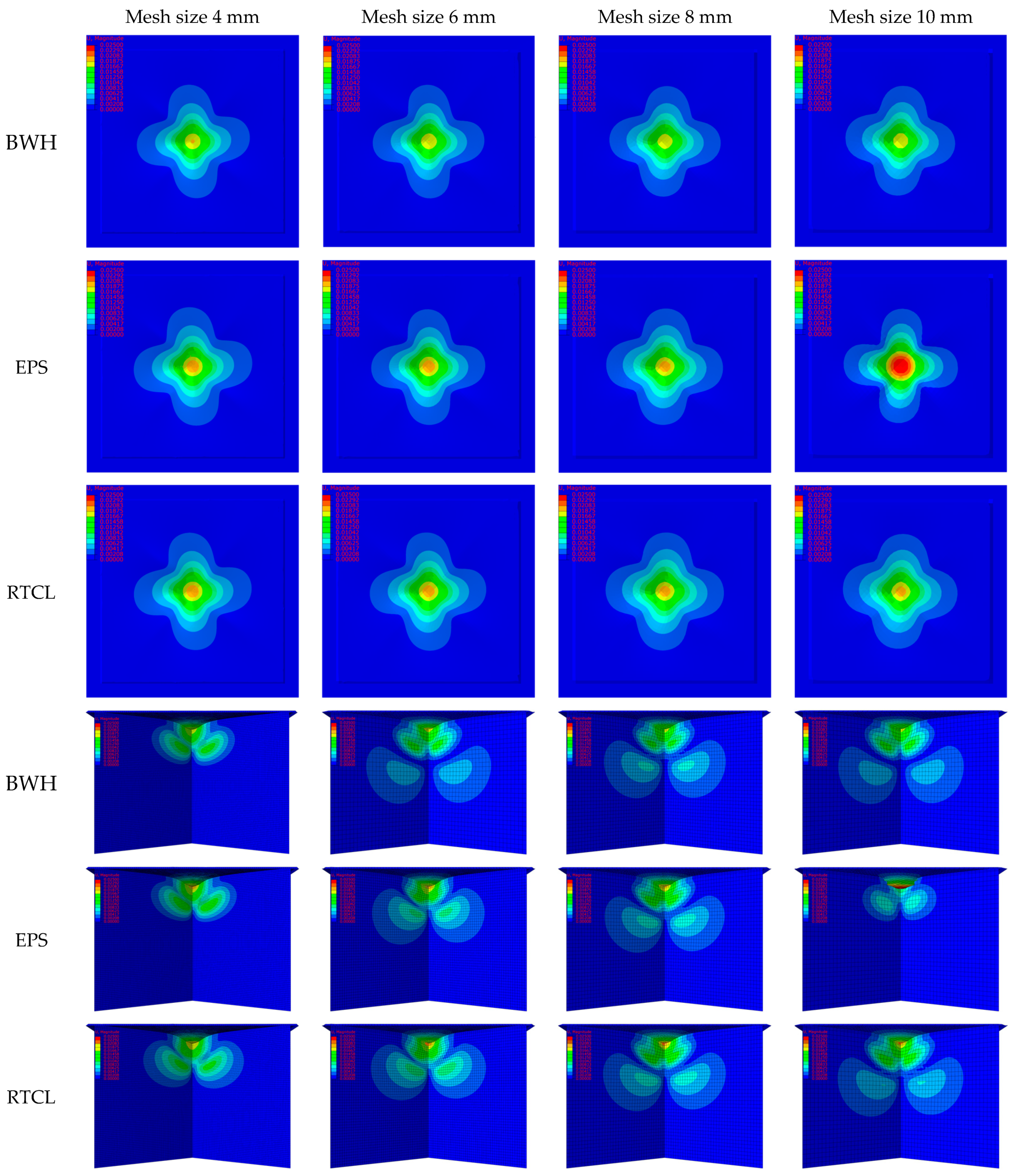
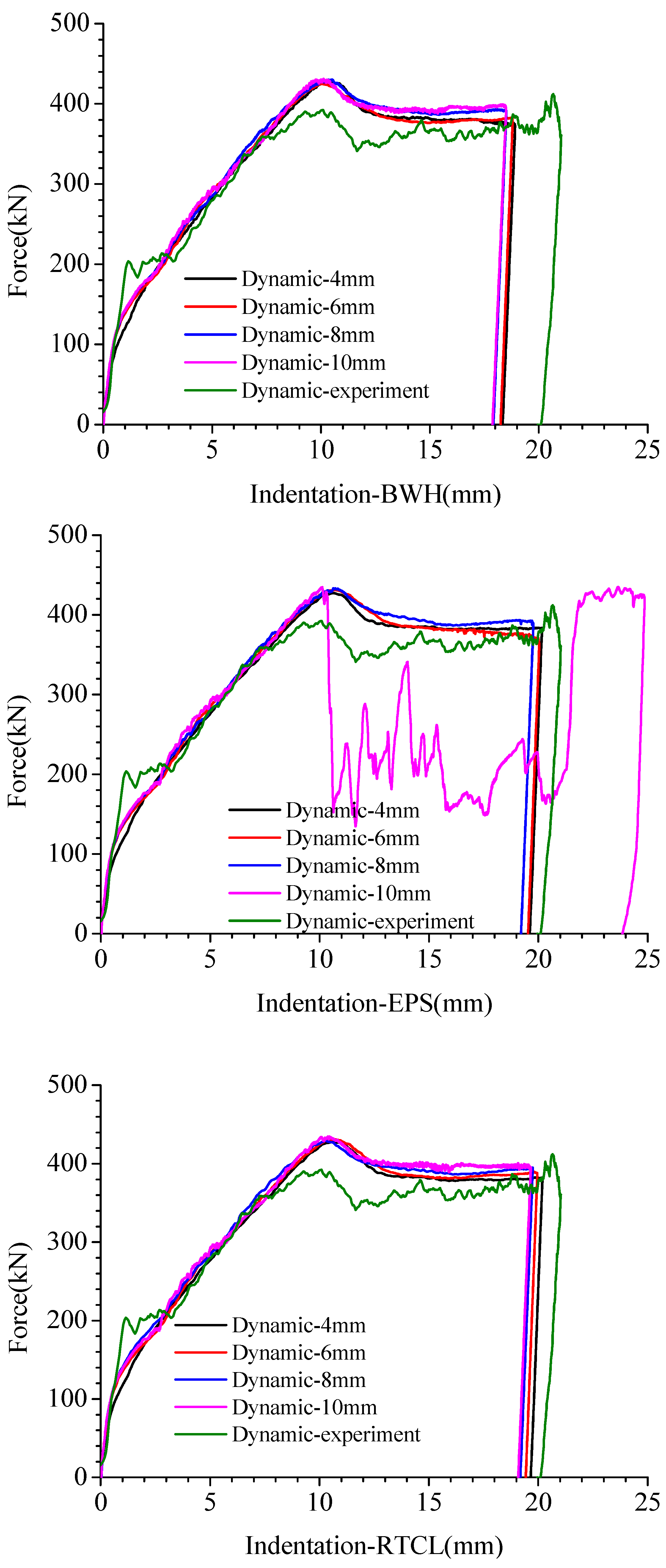
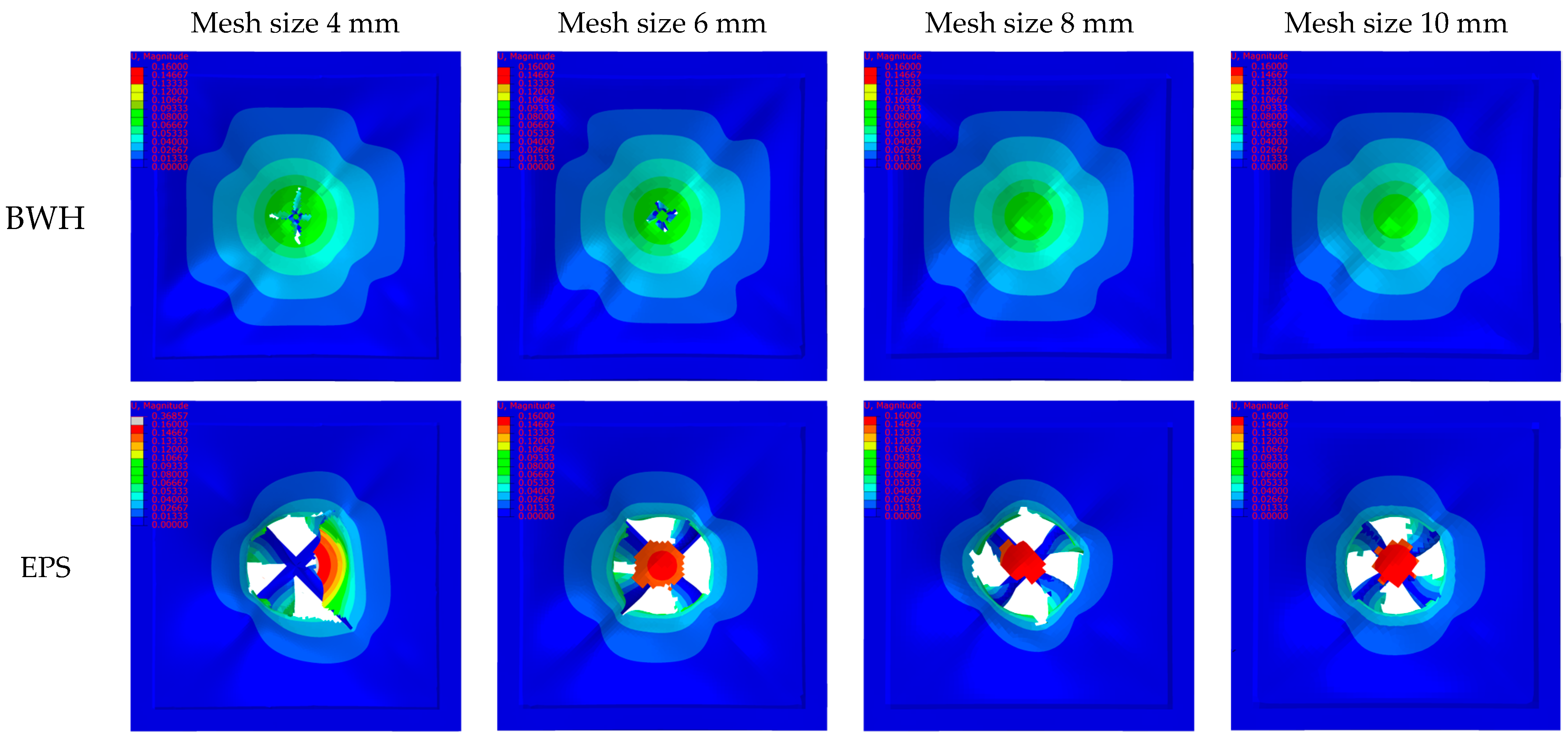
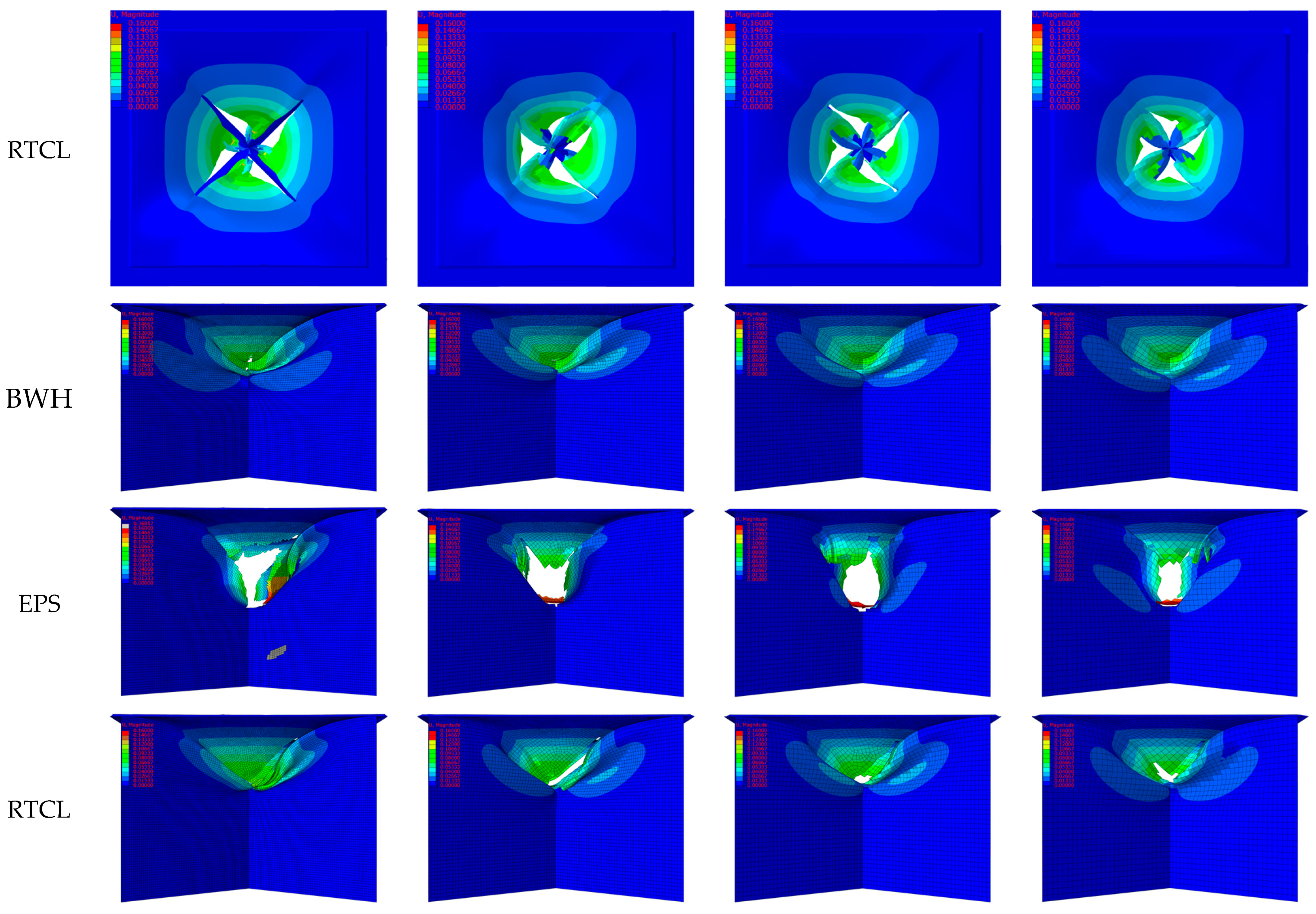
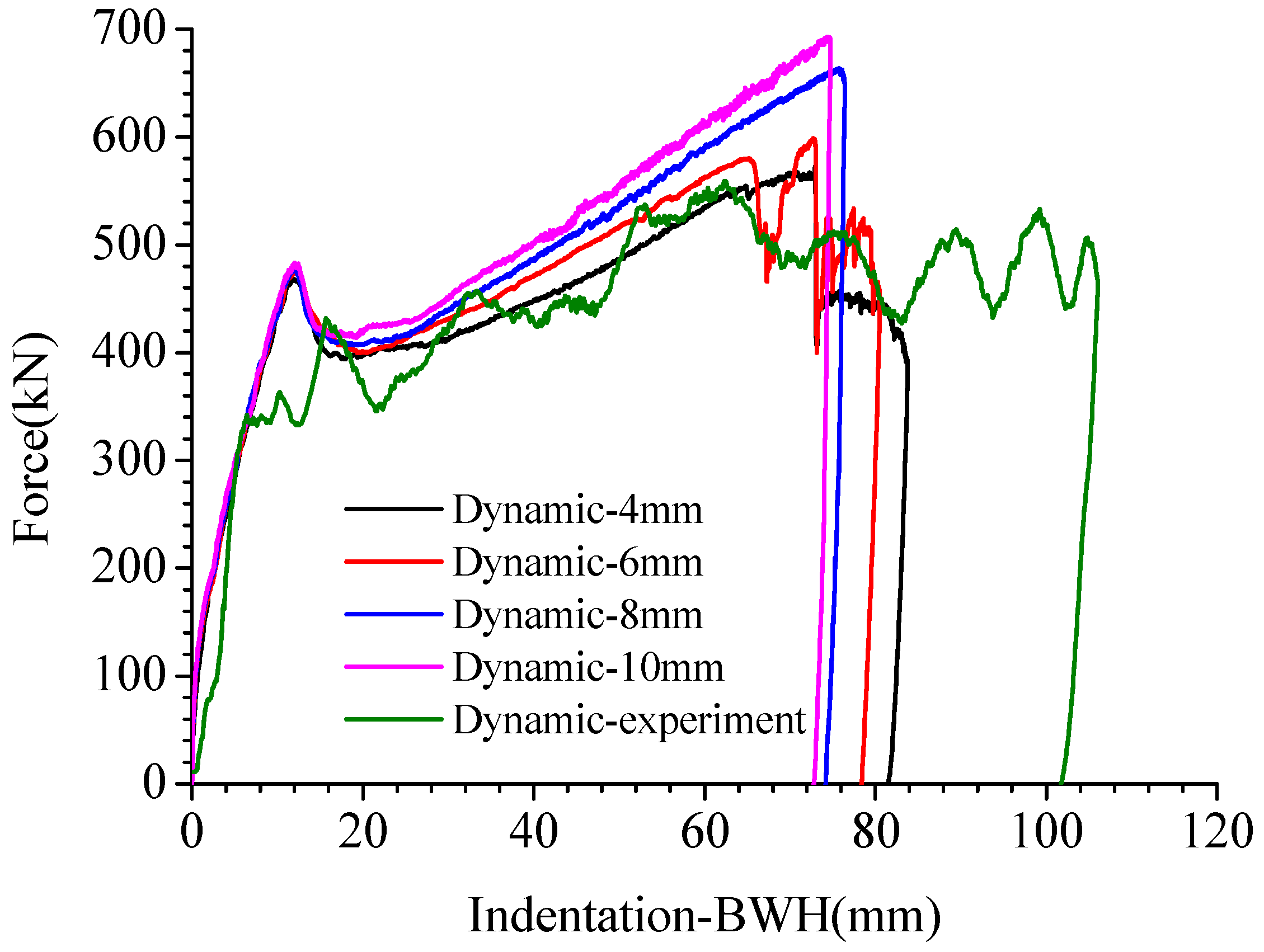
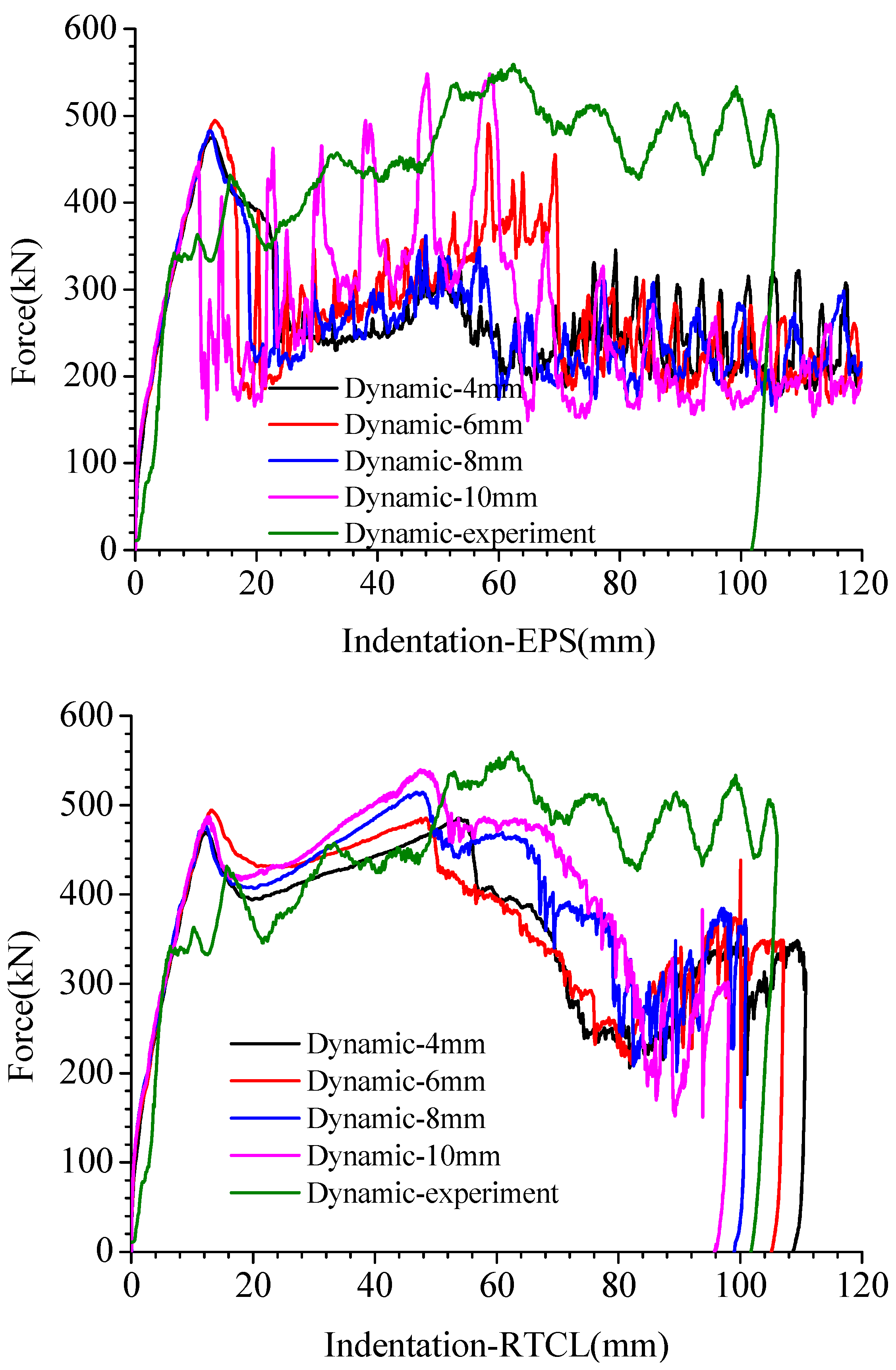
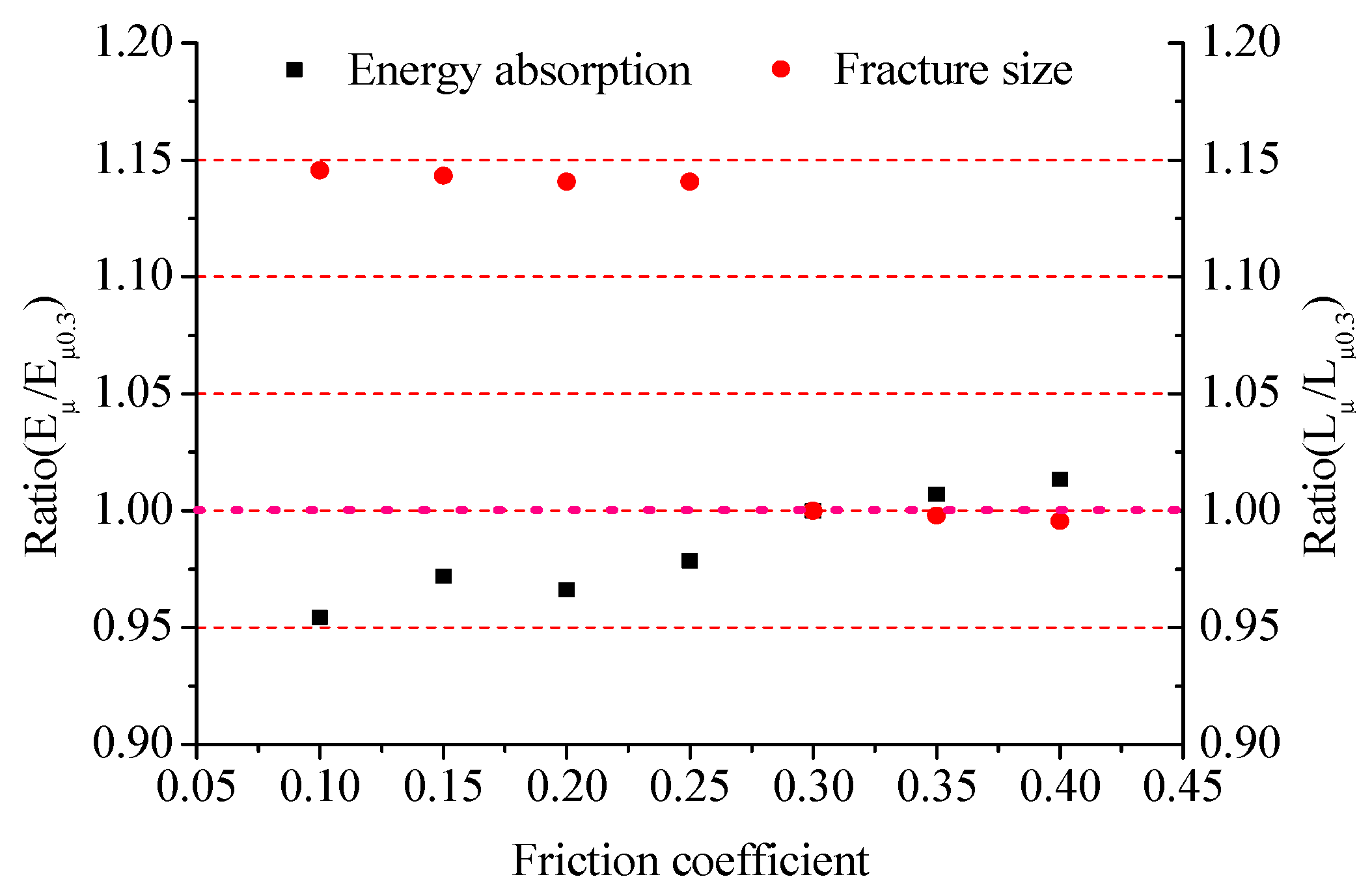
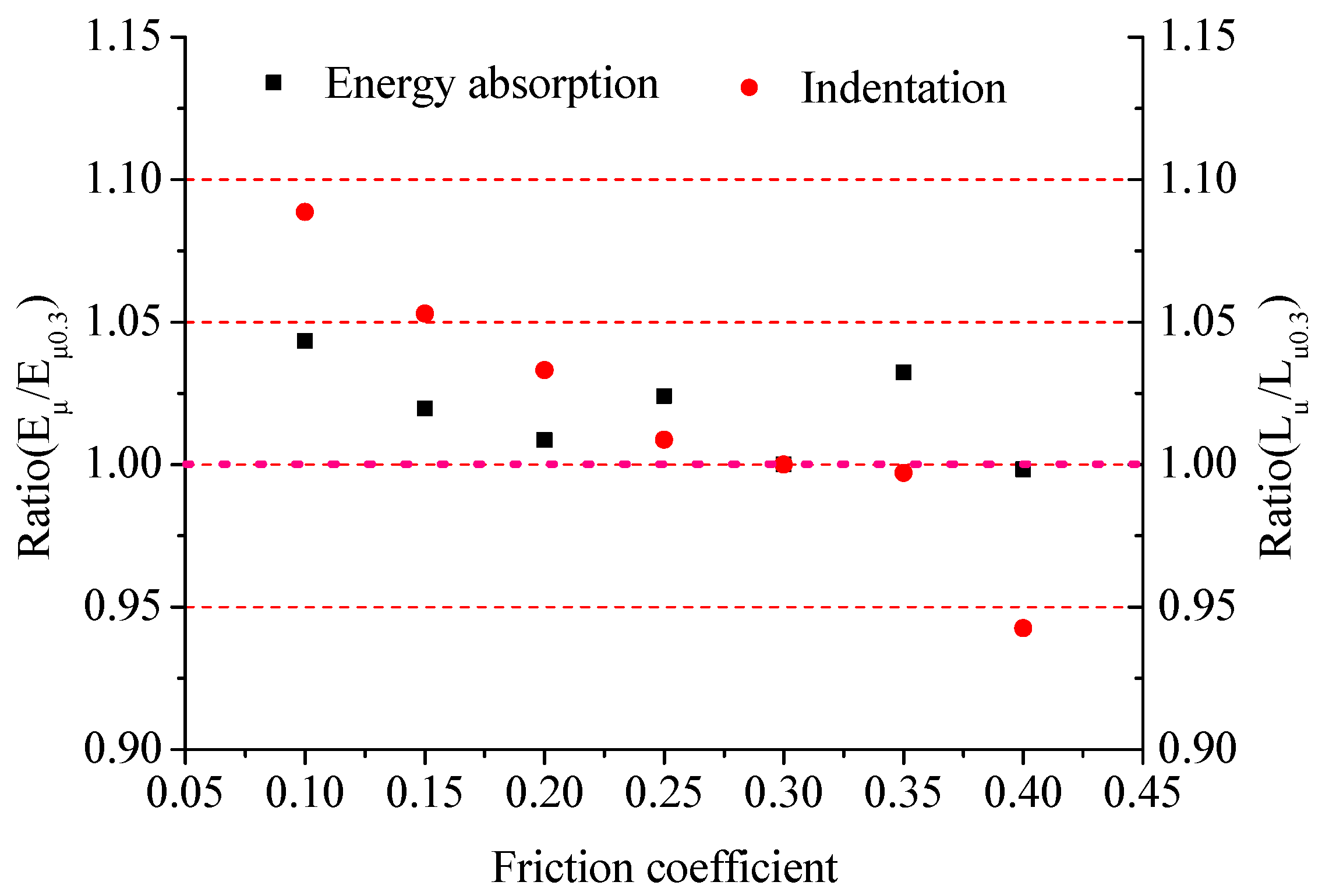

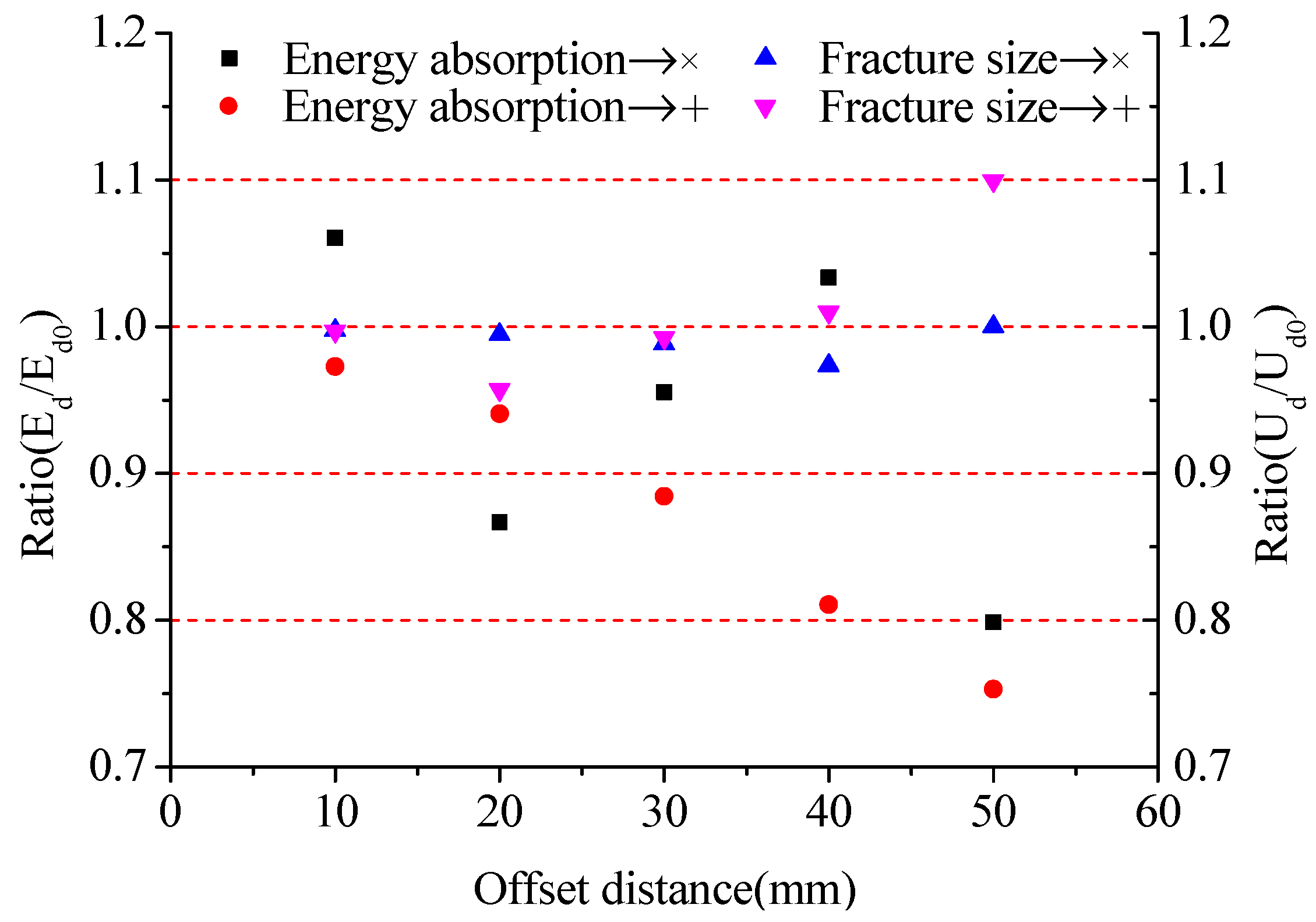
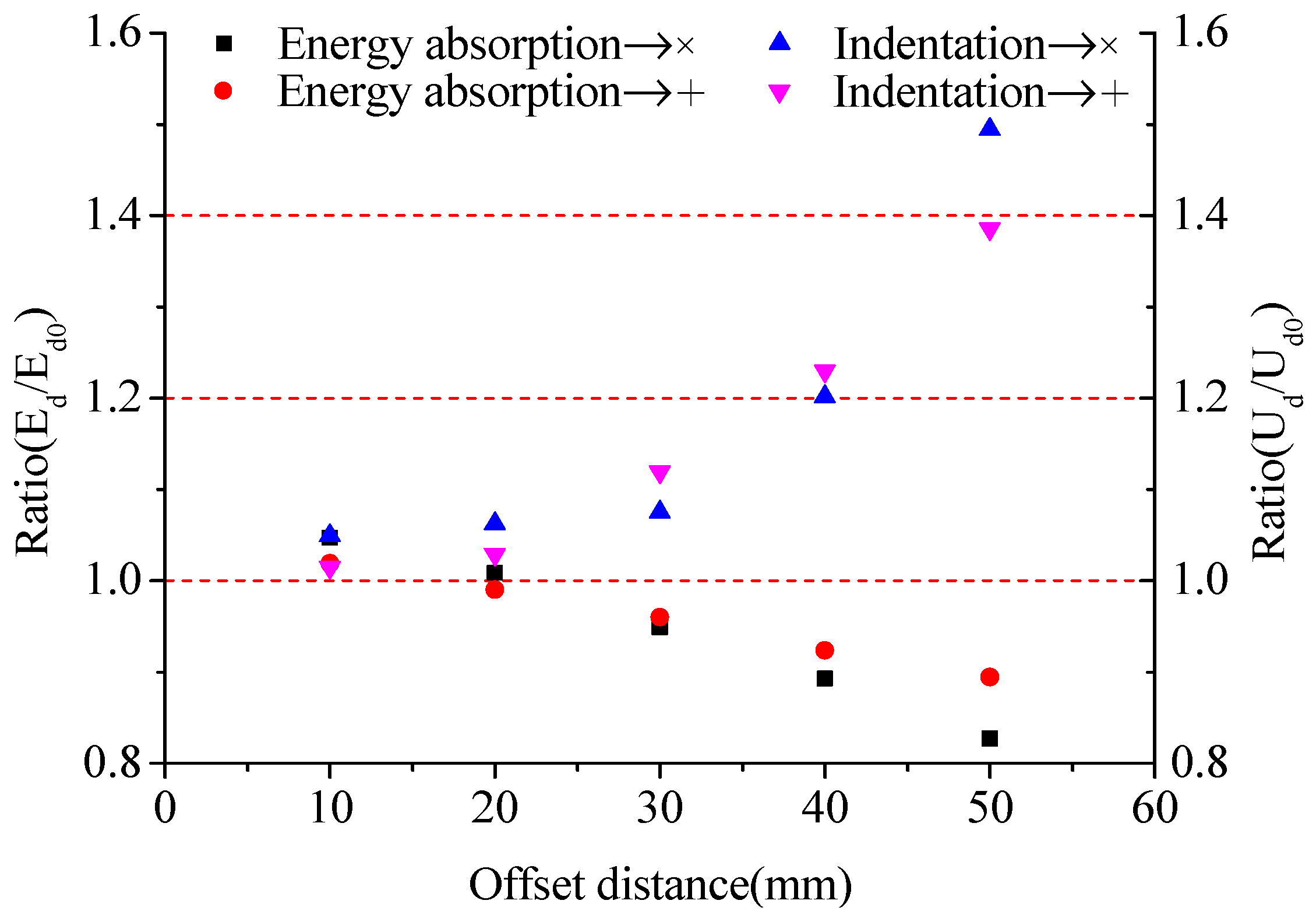
| Parameter | Unit | Value |
|---|---|---|
| Density | kg/m3 | 7850 |
| Elastic modulus | GPa | 213 |
| Poisson’s ratio | - | 0.3 |
| Yield stress | MPa | 221 |
| Ultimate tensile stress | MPa | 353 |
| Fracture strain | - | 0.35 |
| Mesh Size/mm | Finite Element Model | Failure Criteria | |
|---|---|---|---|
| Model 1 | 10 × 10 |  | 0.293 |
| Model 2 | 8 × 8 |  | 0.306 |
| Model 3 | 6 × 6 |  | 0.33 |
| Model 4 | 4 × 4 |  | 0.382 |
Disclaimer/Publisher’s Note: The statements, opinions and data contained in all publications are solely those of the individual author(s) and contributor(s) and not of MDPI and/or the editor(s). MDPI and/or the editor(s) disclaim responsibility for any injury to people or property resulting from any ideas, methods, instructions or products referred to in the content. |
© 2023 by the authors. Licensee MDPI, Basel, Switzerland. This article is an open access article distributed under the terms and conditions of the Creative Commons Attribution (CC BY) license (https://creativecommons.org/licenses/by/4.0/).
Share and Cite
Wang, X.; Liu, K.; Xu, M.; Liu, H. Plastic Response and Failure of the Cruciform Structure under In-Plane Load. J. Mar. Sci. Eng. 2023, 11, 1478. https://doi.org/10.3390/jmse11071478
Wang X, Liu K, Xu M, Liu H. Plastic Response and Failure of the Cruciform Structure under In-Plane Load. Journal of Marine Science and Engineering. 2023; 11(7):1478. https://doi.org/10.3390/jmse11071478
Chicago/Turabian StyleWang, Xiufei, Kun Liu, Mingcai Xu, and Hewei Liu. 2023. "Plastic Response and Failure of the Cruciform Structure under In-Plane Load" Journal of Marine Science and Engineering 11, no. 7: 1478. https://doi.org/10.3390/jmse11071478
APA StyleWang, X., Liu, K., Xu, M., & Liu, H. (2023). Plastic Response and Failure of the Cruciform Structure under In-Plane Load. Journal of Marine Science and Engineering, 11(7), 1478. https://doi.org/10.3390/jmse11071478






